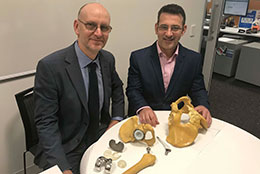02 July 2018
 South Australian researchers are embarking on a $20 million medical and manufacturing research project which could reduce the chance of infection after orthopaedic surgery, thanks to a little help from the humble dragonfly.
South Australian researchers are embarking on a $20 million medical and manufacturing research project which could reduce the chance of infection after orthopaedic surgery, thanks to a little help from the humble dragonfly.
Working with leading surgeons and an Australian orthopaedic medical device company, researchers from the University of Adelaide and University of South Australia (UniSA) will use nano-modification technology based on the structure of the dragonfly wing, whose tiny spikes rip bacteria apart.
The researchers hope to create medical implants with the antimicrobial surface to reduce the likelihood of infections after surgery.
In a unique R&D and manufacturing environment, researchers are carrying out a range of groundbreaking experiments to test whether mimicking the nano-patterns of the dragonfly wing on orthopaedic implants can kill harmful bacteria that cause infections.
The four-year project, co-funded by Global Orthopaedic Technology and the Innovation Manufacturing Cooperative Research Centre (IMCRC), could give scientists and clinicians a critical breakthrough in their global fight against antibiotic resistant bacteria, and is intended to create new technologies and processes to benefit the wider manufacturing sector.
Professor Richard de Steiger, a leading Australian orthopaedic surgeon involved in clinical research, says implant infection post-surgery is a billion-dollar problem worldwide, affecting around 2-3 per cent of medical implants, including devices to stabilise fractures, hip and knee replacements and spinal implants.
“There has been minimal improvement in orthopaedic infection rates for the past 15 years,” Professor de Steiger says.
“Infection after surgery is a devastating problem, costing not only hundreds of millions of dollars in additional surgery worldwide, but leading to more trauma for patients. They may need extra recovery time after further operations, which are not always successful and pose an even greater risk of infection,” he says.
Leading scientists from the University of Adelaide and UniSA will combine their expertise to create titanium implants with the dragonfly wing surface while confirming their safety and testing their bacteria-killing properties in the University of Adelaide’s Centre for Orthopaedic and Trauma Research (COTR) and UniSA’s new Musculoskeletal Biotest Facility.
“This research is a combination of cell biology and very clever nanomanufacturing techniques, driven by an unmet medical need,” says University of Adelaide leading orthopaedic researcher Professor Gerald Atkins, Scientific Director of COTR. “It is game-changing Australian technology.”
UniSA Professor Krasimir Vasilev adds: “This is amazing technology that has the potential to improve the quality of life of millions of patients around the world. The project is also a great example of transdisciplinary collaboration between scientists, clinicians and industry, transforming healthcare, manufacturing industry and the Australian economy.”
The bacteria-busting qualities of the dragonfly were first identified by Australian researchers who observed bacteria being killed on the insects’ wings, characterised by tiny spikes – nanopillars – which are about one thousandth of the thickness of a human hair.
Global Orthopaedic Technology is taking the technology a step further, partnering with “the best researchers in Australia” to commercialise the technology and tackle the growing epidemic of resistant bacteria and resulting infections.
David Chuter, IMCRC’s CEO and Managing Director, says this research project is reshaping not only the future of the medical device industry, but potentially other sectors.
“Due to the nature of the nano surface, which is independent of the chemistry and material properties of the substrate to which it is applied, the technology can potentially be used in other manufacturing processes across multiple industries, most notably the hospital supplies and equipment industry, the food industry, the marine industry, the building products industry, and the aeronautical industry.
“The new technology will open many doors, not just in the medical field, as antibacterial surfaces are also valuable in the food industry - in fact, for any surfaces subject to high levels of bacteria.”
Global Orthopaedic Technology and IMCRC are each providing a $3 million cash investment as part of a total medical and manufacturing R&D investment of $20 million, with the additional funding provided through in-kind contributions from Global Orthopaedic Technology and both universities.
Media contacts: University of Adelaide Robyn Mills mobile 0410 689 084 email robyn.mills@adelaide.edu.au;
UniSA Candy Gibson mobile 0434 605 142 email candy.gibson@unisa.edu.au;
For more information on the IMCRC and manufacturing research projects: www.imcrc.org



